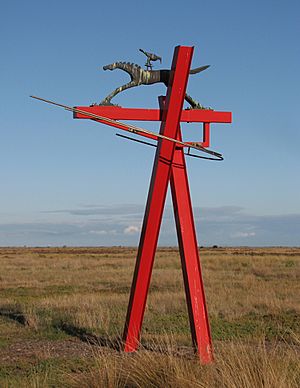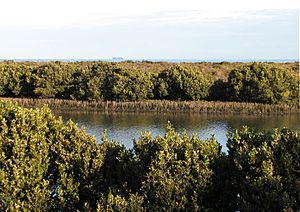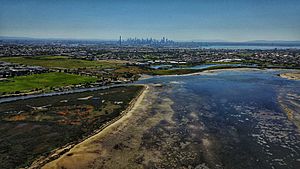Altona Coastal Park facts for kids
Altona Coastal Park is a special natural area located about 11 kilometers (7 miles) from Melbourne city center, in the western suburb of Altona. This park covers 70 hectares (about 170 football fields!) and includes unique areas like salt marshes and intertidal zones (where the land is covered by water at high tide and exposed at low tide). It's a very important place for nature and a great spot for people to visit. Many different plants and animals call this park home, and it's even part of the Cheetham and Altona Important Bird Area.
Contents
History of Altona Coastal Park
This area has a long and interesting past. From 1864 to 1940, it was home to the Williamstown Racecourse, where horse races took place. The racecourse closed in 1940 to make way for an army camp during World War II.
Over the years, the land was changed a lot by adding soil and building things. It was known as the Altona Sports Park before it got its current name. Today, you can still see parts of the old Williamstown Racecourse Grandstand and a palm tree that stood at its entrance.
To remember the racecourse, a 4-meter (13-foot) tall sculpture called "Requiem for a Champion" was put in the park. It was made by artist Yvonne George and shows a bronze stint (a type of bird) sitting on a galloping horse.
Plants of Altona Coastal Park
The park is mostly covered in saltmarsh plants. You'll find plants like shrubby glasswort and beaded glasswort here. These plants are very important because they provide food for the rare orange-bellied parrot.
The park is home to at least eight types of plants that are rare in the region. This includes White Mangroves (Avicennia marina), which grow along the southern banks of Kororoit Creek.
Large areas of a plant called Carpobrotus rossii also grow in the park. In late October, this plant blooms with beautiful pink flowers, creating a stunning sight.
People are working hard to protect and improve the park. They have programs to plant more native plants and remove weeds. This helps the area support even more different kinds of animals.
Animals of Altona Coastal Park
Altona Coastal Park is a paradise for animals, especially birds! At least 149 different bird species have been seen here. Out of these, 13 are rare or endangered, making the park a crucial habitat for their survival.
You can spot many aquatic (water) birds like black swans, black ducks, pelicans, stilts, and gulls. Terrestrial (land) birds include colorful blue wrens, rosellas, magpie larks, and ravens.
At night, two types of tiny bats, Gould's Wattled Bat and the White Striped Freetail bat, fly around hunting insects.
If you're exploring the grasslands and rocky areas, you might even see tiger snakes. In the sea and creeks, there are lots of native fish, crabs, oysters, cockles, and periwinkles.
Geology and Landforms
The land in Altona Coastal Park changes a lot. In the inner areas, you'll find grassy plains. Closer to the coast, it turns into salt marsh, shallow mudflats, and rocky platforms made of basalt rock.
Kororoit Creek flows right through the park and empties into Port Phillip Bay. The wetland area where the creek meets the bay is very important for its unique landforms, as are the large sand bars found off Kororoit Creek.
The park also acts as a protective area for the Wader Beach, which is part of the Jawbone Flora and Fauna Reserve. This reserve is located between Williamstown and Altona.
Fun Things to Do at Altona Coastal Park
Altona Coastal Park is a popular spot for many activities. People love to come here for walks, bike rides, and to walk their dogs. The Hobsons Bay Coastal Trail even passes right through the park.
The park's wide-open spaces offer amazing views of Port Phillip Bay and the Melbourne city skyline across the salt marsh. When the tide is low, the seawater pulls back a lot, letting you walk far out into the sea. The park is also used by scientists and students for research and study.




